5 - Joints
Editors: Mills, Stacey E.
Title: Histology for Pathologists, 3rd Edition
Copyright 2007 Lippincott Williams & Wilkins
> Table of Contents > III - Musculoskeletal System > 8 - Skeletal Muscle
function show_scrollbar() {}
8
Skeletal Muscle
Reid R. Heffner Jr.
Lucia L. Balos
Introduction
Skeletal muscle is the largest organ in the body by weight and volume. There are hundreds of individual muscles comprising the skeletal musculature. The functions of these muscles encompass not only the movement of skeletal components, but also swallowing, respiration, and maintaining posture. The variation in the gross anatomy of these muscles is considerable. More to the point for our purposes are the histologic characteristics of muscle in general and the site-specific variations such as fiber size and fiber-type proportions. Since the anatomic pathologist is increasingly called upon to interpret microscopic findings in muscle as they relate to disease, a familiarity with the histology of normal muscle is the basis of any accurate assessment of this kind. Today, an understanding of muscle histology in a modern context depends upon some knowledge of developmental biology and molecular biology.
Embryology
The development of skeletal muscle is orchestrated in the unborn baby by a host of genes, many of which are yet unknown. These genes have the function of regulating the transformation of mesenchyme into muscle tissue and of reorganizing previously formed tissue through processes like apoptosis. We will have more to say about the molecular biology of muscle development after a discussion of some basic embryology. Skeletal muscle develops embryologically from somatic mesodermal tissue. The paraxial mesoderm is first apparent on day 17 and is the origin of the somites that are completely formed by day 30. At this time, a series of 42 to 44 pairs of rounded somites can be found adjacent to the notochord in the midline. By the fourth week, the mesodermal somites separate into the dermatomes and segmental myotomes. The latter give rise to the muscles of the body wall. The dorsal division of myotomes, the epimeres, represent the origin of the back muscles, while the ventral division hypomeres differentiate into the lateral and ventral muscles of the body wall, including the intercostals, abdominal obliques, and strap muscles of the neck. The muscles of the extremities arise from the limb buds that form from the lateral plate mesoderm that is also the origin of the bone, tendon, ligaments, and blood vessels. In the human embryo the mesenchyme of the limb buds appears at about the fourth week of gestation and is subject to induction by the somites. At the end
P.196
of the eighth week, the primordia of individual muscles can be appreciated. Muscle tissue is not derived directly from the lateral plate mesoderm (as was previously thought) but from somitic mesoderm, which invades the limb bud in week 5 (1). Differentiation of the limb musculature follows a cephalocaudad and proximal-to-distal progression. In each limb, the somitic mesenchyme subdivides into a dorsal and ventral mass with respect to the skeletal elements. The extensor, abductor, and supinator muscles are derived from the dorsal mass, whereas the flexor, adductor, and pronator muscles originate from the ventral mass (2).
The most immature muscle cells are myoblasts. These are small, round, mononucleate cells with prominent nucleoli and evidence of mitotic activity. Myoblast cytoplasm contains no microscopically detectable filaments, but ribosomes can be identified. Masses of proliferating myoblasts represent the source of myotubes, the next step in myogenesis (3). Myotubes appear to arise as a result of fusion of the more primitive myoblasts (4). Myoblast fusion has been shown to depend upon a plasma membrane glycoprotein with a molecular weight of 38 KDa (5). This surface marker presumably allows fusing myoblasts to recognize each other. The 38-KDa membrane protein is also found on immature myotubes and satellite cells. Ultrastructurally, myoblasts are seen to have contact with each other through filopodia. Adjacent myoblasts are often joined by gap junctions (6). Fusing myoblasts become longitudinally oriented, a process which requires fibronectin (7). At this stage of myogenesis, groups of primitive muscle cells, including myoblasts and myotubes, are enclosed by a common basement membrane. In each cluster, there is usually one larger primary myotube. Between groups of cells are aggregates of interstitial cells (8).
Myotubes differ from myoblasts by the presence of multiple nuclei and cytoplasmic filaments. Filaments first form at the peripheral portions of the sarcoplasm and consist of 10 nm fibroblast-like fibrils that disappear during maturation (9). Immunohistochemical techniques also demonstrate the presence of desmin and vimentin within myotubes. More mature secondary myotubes have a larger diameter, increased numbers of nuclei that are central in cross sections, and more prominent myofilaments (Figure 8.1). These cells also begin to show evidence of contractile activity. Secondary myotubes eventually give rise to muscle fibers. As they approach this stage of development, secondary myotubes cease fusing and develop acetylcholine receptor protein on the cell surface. At first receptor protein is diffusely distributed on the cell surface, but it later becomes focused into so-called hot spots where motor endplates will develop (10).
Muscle fibers differ from myotubes in that their nuclei are peripheral and their filaments are organized into sarcomeres. Muscle fibers also develop a sarcotubular system, and in time they become innervated. Immature muscle fibers often acquire multiple innervation sites, all but one of which eventually disappears.
 |
Figure 8.1 Myotube stage of muscle development. Myotubes typically have large central nuclei (trichrome). |
The number of myotubes continues to decline after the twenty-first week of gestation so that at the time of birth myotubes are no longer conspicuous histologically. As myotubes become fewer in number, the muscle fibers undergo histochemical differentiation, which begins in the fifth month of development. Between fifteen and twenty weeks of gestation, a primitive progenitor of the checkerboard pattern emerges in which all myotubes and myofibers have high ATPase and oxidative enzyme activity (11). By twenty weeks gestation, approximately 10% of fibers are larger in diameter, with both high oxidative enzyme activity and reduced ATPase activity. These fibers, which are basophilic in H&E stains, are the so-called Wohlfart B fibers and are the earliest example of type 1 fibers to be detected in developing muscle (12). The remaining 90% of fibers (Wohlfart type A) correspond to type 2 fibers with enhanced ATPase activity. Although type 2A and 2B fibers are not yet visible, a few type 2C fibers that stain dark in both acid and alkaline ATPase reactions are apparent. These fibers typically immunostain with antibodies to both fast and slow myosin. The more mature checkerboard histochemical pattern, which is stimulated by the innervation of fibers, is almost completed between 26 and 30 weeks of gestation (13). At birth the histochemical mosaic begins to resemble that of mature adult muscle. Approximately 80% of fibers are clearly identified as type 1 or type 2. The remaining 20% are undifferentiated fibers that have both abundant oxidative enzyme activity and stain darkly in routine ATPase reactions. A few Wohlfart type B fibers remain at birth. Type 2C fibers are not encountered.
As mentioned earlier, the development of skeletal muscle is under the control of several categories of genes and their products (14). Among these categories are transcription factors and signaling molecules such as growth factors and their receptors. A comprehensive discussion of this subject would not be appropriate, but a few illustrative examples will be given in recognition of the fact that these
P.197
molecular events in the embryo will soon be relevant in the understanding and diagnosis of muscle disease, especially the congenital myopathies and dystrophies.
One of the important influences in the early stages of segmentation when the segmental identity of the somites is established is the expression of Hox genes, a family of homeobox genes that act as transcription factors involved in craniocaudal segmentation of the body. Myogenesis originates with a population of mesenchymal cells that become devoted to a lineage of myogenic cells. The molecular basis of this transition rests with an array of myogenic regulatory factors, MyoD, myogenin, Myf-5, and MRF-4, which are basic helix-loop-helix proteins. Both Myf-5 and another transcription factor, Pax-3, activate MyoD (myogenic determining factor), which leads to the formation of mononuclear myoblasts. Meanwhile, myoblasts in the myotome of the somite continue to replicate and are kept in the cell cycle by growth factors such as fibroblast growth factor (FGF-8). Myogenin expression is controlled by Myf-5 and MyoD; along with myoblast recognition and adherence mechanisms that rely on adhesion molecules like M-cadherin, myogenin expression promotes myotube fusion. In turn, MRF-4 is responsible for differentiation into myofibers.
Postnatal and Developmental Changes
During the prenatal period and childhood, muscle fibers continue to increase in length until full growth is attained. Muscle fibers lengthen in response to growth of the skeleton by virtue of two fundamental changes in the sarcomeres. Existing sarcomeres lengthen, producing longitudinal fiber growth (15). This mechanism may account for up to a 25% increase in fiber length and indicates that there is a relative excess of sarcomeres that may elongate during periods of rapid growth of the skeleton. Muscle fibers also undergo real longitudinal growth with the addition of new sarcomeres, which involves the synthesis of contractile proteins (16). New sarcomeres are known to be added at the end of fibers, usually at the myotendinous junctions (17). There is also evidence to suggest that new sarcomeres are not only added at the end of fibers, but within internal segments as well. Whether the actual number of muscle fibers is augmented after birth is the subject of a current debate. Until recently the myofiber population was thought to be relatively stable after birth and throughout adult life (18). The studies of Adams and DeReuck (19) and others, however, seem to suggest a gradual rise in the number of fibers between birth and the end of the fifth decade. In some muscles, the total increase in fibers may reach 80 to 100% of the neonatal level. The mechanism accounting for an increase in the fiber population probably involves a population of dividing stem cells that subsequently undergo fusion to produce new mature fibers. A major aspect of growth of muscle fibers after birth relates to an increase in transverse dimension. In general, between birth and adulthood there is a five-fold increase in muscle fiber diameters (20). For example, in the leg muscles, the average diameter of mature fibers is 45 m as compared to 7 m at birth. The enlargement in fiber diameters does not proceed at an even rate from birth to early adulthood, when fibers obtain a maximum diameter. Instead, fiber diameters increase at a relatively slow rate until puberty, when a burst of growth occurs. As an example, in the gastrocnemius, fibers more than triple in size from age 12 (average 19 m) to age 21 (average 62 m) years.
A major revision in the histochemical profile of muscle occurs after birth. In the term infant, a checkerboard staining pattern is clearly evident in alkaline ATPase reactions. However, fiber typing is often not distinct in oxidative enzyme reactions (Figure 8.2). The emergence of type 1, 2A, and 2B fibers in oxidative preparations occurs during infancy. Undifferentiated fibers having both abundant oxidative enzyme and ATPase activity represent approximately 20% of fibers at birth. These gradually differentiate into type 1 and type 2 fibers during the first year of life. The fate of Wohlfart B fibers, comprising about 1% of myofibers at birth, is unknown. They are not seen in biopsies of children past the age of 12 months.
The connective tissue elements of muscle are much more prominent at birth, particularly the perimysial components. Immediately after birth the perimysium may account for up to 20% of the cross-sectional area of muscle tissue. During early childhood, the perimysium and other connective tissue components rapidly shrink to less than 5% of the cross-sectional area, in part because of the enlargement of the muscle fibers. In the immediate postnatal period, blood vessels (especially arteries) appear excessively thickened as a result of the presence of abundant smooth muscle elements.
P.198
Expansion of the luminal diameter of blood vessels in the first year of life gives the vascular elements an adult appearance. The noncontractile, supporting connective tissue contains abundant collagen and scattered fibroblasts. Foci of hematopoiesis remain after birth, containing stem cells, erythroblasts, and myelocytes. These foci are more likely to be seen in the distal muscles of the extremities. They disappear within one month after birth.
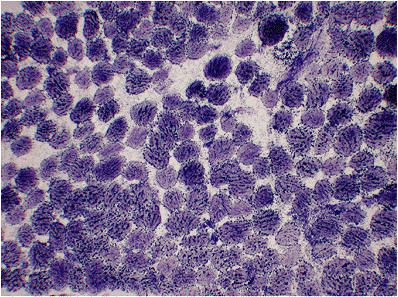 |
Figure 8.2 Newborn muscle. Indistinct fiber typing is evident in oxidative enzyme reactions (NADH-TR). |
Apoptosis
Our scientific knowledge of apoptosis in skeletal muscle is at a rudimentary stage, but the medical literature is beginning to address apoptosis as a regulatory process in the normal development of muscle and in its relationship to selected pathologic conditions (21).
During embryologic life, both neurons and skeletal muscle are affected by the process of apoptosis. A great deal more is known about programmed cell death in nerve cells, including motor neurons, than in muscle. A review of the earlier literature discussing natural neuronal death has been published by Hamburger (22). A recent article by Sohal (23) addresses the subject of embryonic development of motor neurons and muscles, culminating in the establishment of mature nerve-muscle relationships. During embryogenesis, a necessary remodeling of muscles occurs through apoptosis, which removes unwanted cells or structures to make room for further maturation. In the chick embryo, programmed cell death clearly occurs as the myofibers are developing. The large diameter primary myotubes are preferentially affected. The cytological features suggesting apoptosis include misshapen nuclei and irregular chromatin condensations along the nuclear envelope (24). It has been shown that, in rat embryos, macrophages play an important role in the removal of dead fibers (25). In human fetal muscle, the programmed cell death of both primary and mature myotubes occurs between 10 and 16 weeks of gestation (26).
A body of information regarding apoptotic events in postnatal and adult muscle is beginning to accumulate. Such diverse conditions as disuse, exercise, ischemia, aging, and certain myopathies are being examined. Skeletal muscle apoptosis differs from most other tissues in several ways. Muscle cells are multinucleated, and their mitochondrial composition varies with fiber type and other factors such as exercise. Muscle cells contain two separate mitochondrial populations, subsarcolemmal and intermyofibrillar. It is unclear at the moment whether the expression of pro- and antiapoptotic agents differ in the two populations. Because it is a multinucleated cell, the muscle fiber does not always undergo apoptosis in same fashion as other cell types. Damage limited to individual myonuclei seems to be more common than death of the entire cell. In denervation, myonuclear loss leads to fiber atrophy instead of cell death. Finally, the elevated expression of endogenous caspase inhibitors in muscle seems to confer relatively greater resistance to apoptosis.
Anatomy
There are 434 voluntary muscles in the human body (27). They comprise 25% of the total body weight at birth and 40 to 50% of the total weight in adults. Not surprisingly, a greater muscle mass is encountered in males than in females. Individual muscles vary greatly in size. For example, the smallest muscle in the body, the stapedius, measures only 2 mm in length. On the other hand, the sartorius and other large muscles of the extremities measure up to 2 feet in length (61 cm). Skeletal muscles are composed of varying numbers of muscle fibers (e.g., 10,000 in lumbricals and 1,000,000 in gastrocnemius) (28). These are connected at both ends to tendons or the epimysium.
Because the fibers work in conjunction with each other, they are aligned in the same direction. Few skeletal muscles are modeled after the lumbricals, where all the fibers are arranged in a fusiform structure that tapers at either end at the site of tendinous insertion (29). The more familiar unit is a parallelogram composed of muscle fibers that insert at both ends on a flat tendon composed of dense collagen. In a parallel muscle, the fascicles are parallel to the longitudinal axis of the muscle, as in the thyrohyoid. In oblique muscles, a tendon typically runs within the muscle or on its surface, and the muscle fibers insert obliquely on the tendon. Oblique muscles are most often pennate or featherlike. Some are bipennate, much like a feather in which there is a central shaft from which a series of barbs radiate on either side. Such muscles have a central tendinous structure from which two sets of parallel muscle fibers radiate (e.g., peroneus longus). Other muscles are simple pennate, in which only one set of parallel muscle fibers attaches obliquely on a shaftlike tendon (e.g., extensor digitorum longus). Muscles are designated as complex pennate when the muscle consists of multiple parallelograms attaching to several tendons in the muscle mass. Not all skeletal muscles follow precisely the model of parallel or pennate design. They may be triangular like the pectoralis minor or spiral in structure like the forearm supinators. Although most muscles are attached to and are involved in moving bony skeletal structures, some voluntary muscles (such as those of the larynx and esophagus) do not have attachments to bone.
The blood supply to individual skeletal muscles has not been extensively studied and is therefore incompletely understood. It is known that the arterial supply to muscles varies somewhat with the individual. In general, the skeletal muscles are subserved by several rather than a single artery, which renders them rather resistant to ischemia from an embolus or from disease of a single vessel. Much of our understanding regarding the pattern of vascularization in human muscle is derived from studies performed by Blomfield (30).
P.199
The vascular supply to skeletal muscle falls into one of five categories.
The blood supply is derived from a single nutrient artery that divides in a longitudinal fashion within the muscle itself. The gastrocnemius is an example of such a system.
The muscle is supplied by several separate arteries entering the muscle along its length. Anastomoses are formed within the muscle between the territories of each artery. This pattern is typical of the soleus.
The blood supply arises from a single main artery that enters the belly of the muscle and subsequently forms a radiating pattern of collaterals, as in the biceps brachii.
In muscles like the tibialis anterior, a pattern of anastomosing arcades is derived from a series of penetrating arteries. This vascular pattern is considered to be the most efficient form of vascularization.
A less efficient form of the anastomosing arcade pattern is the rectangular pattern of anastomoses formed by a series of penetrating arteries. This so-called quadrilateral pattern is seen in the extensor hallucis longus muscle.
Once a main artery enters the muscle substance, it branches into a number of primary intramuscular arteries that ramify in the epimysium and perimysium. The primary arteries, with a diameter which ranges from 80 to 360 m, give rise to numerous secondary arterioles that run parallel to the direction of the muscle fibers. The secondary arterioles often connect to primary arteries, forming artery-to-artery anastomoses. The secondary arterioles, which range in diameter from 50 to 100 m, typically have a thin adventitia composed of fibroblasts and collagen. The smooth muscle coat is much thinner than that of the primary arteries, usually having only two to three layers of cells. The internal elastica is prominent and continuous. The secondary arterioles branch to form terminal arterioles, which measure 15 to 50 m in diameter. Their smooth muscle coat is usually only one layer of cells. The internal elastica becomes discontinuous and is lost in smaller vessels. The distal portions of the terminal arterioles have precapillary sphincters, which are formed from the smooth muscle cells of the media. These sphincters are found in blood vessels with an inner diameter of less than 15 m. Footlike processes between the smooth muscle cells and the endothelium may be seen in the region of the sphincters.
As in other tissues, the arterioles end in an elaborate system of capillaries. In contrast to most other organs, in muscle a relatively small number of capillaries are open at rest (31). During muscle activity there is a considerable increase in the number of open capillaries. A marked difference in capillary density is observed in different muscles, as well as in trained versus untrained subjects. Studies of capillary density reveal that the average single muscle fiber is surrounded by 1.7 capillaries (32). Capillary density may also be expressed as the number of capillaries per fiber, which on average in cross sections is 0.7.
The density of capillaries also reflects oxygen consumption within muscle. Therefore increased numbers of capillaries are evident where larger numbers of type 1 fibers are present. This phenomenon is less evident in humans than in animals such as the cat, in which muscles are composed chiefly or totally of one fiber type. Thus in the cat soleus muscle, which is composed almost entirely of type 1 fibers, the density of capillaries is 1,600 per mm2. In the gastrocnemius, a muscle with far fewer type 1 fibers, the capillary density is 600 per mm2 (33). The capillaries within skeletal muscle travel primarily in a longitudinal direction, although they are frequently linked by short transverse branches.
Ultrastructurally, capillaries are composed of endothelial cells surrounded by a basement lamina. Occasional pericytes are encountered outside the basement membrane. Endothelial cells typically contain numerous pinocytotic vesicles. Where endothelial cells are joined, they lack tight junctions. Hence the capillary endothelium is freely permeable to tracers such as horseradish peroxidase. The capillary pericytes are essentially smooth muscle cells that contain large numbers of filaments. The pericytes are innervated by small-diameter unmyelinated nerve fibers. The basement membrane (which lies between the endothelium and pericytes) measures 20 to 30 nm, although some thickening and reduplication of the basal lamina occurs in older patients.
The nerve supply to individual skeletal muscles often enters the surface of the muscle at the belly and is accompanied by one or more major penetrating arteries. Within the main nerve trunk are myelinated and unmyelinated axons. Contributions to the nerve are made from myelinated efferent motor fibers that innervate the muscle fibers; somatic afferent sensory fibers from muscle spindles, Golgi tendon organs, and Pacinian corpuscles; and unmyelinated autonomic efferent fibers. At least 50% of the fibers are sensory in function. The motor fibers that innervate the myofibers demonstrate a bimodal size distribution. The large diameter fibers innervate fast motor units, while the fibers are distributed to slow motor units and some intrafusal fibers of the muscle spindle. The very small diameter fibers supply the remainder of the muscle spindle fibers. The large motor fibers are relatively uniform in diameter, measuring between 10 and 15 m. The small motor fibers vary from 2 to 7 m in diameter.
As the distal motor axon approaches the muscle fiber, it is transformed into the terminal axon, which represents the proximal portion of the neuromuscular junction, or motor endplate (MEP). The neuromuscular junction, measuring about 50 m in diameter, is composed of the presynaptic (PRS) portion or terminal axon and the postsynaptic (POS) portion, which is formed by a unique region in the muscle fiber (Figure 8.3). The PRS and POS domains are separated by a specialized, 50-nm wide intercellular space, the synaptic cleft.
The myelinated motor nerve terminates at the PRS region as an unmyelinated axonal segment that is enveloped
P.200
by the teloglia, the distal projections of Schwann cells. The terminal axon and teloglia are covered by a layer of endoneurium, the sheath of Henle, which becomes continuous with the endomysium of the muscle fiber in the area of MEP. Numerous synaptic vesicles, each 45 to 50 nm in diameter, are found in the terminal axon. The vesicles are most plentiful around thickened zones of increased electron density at the presynaptic membrane. Studies utilizing freeze-fracture electron microscopy have demonstrated that parallel pairs of double rows of intramembranous particles, measuring 10 nm in diameter, are located at these electron dense zones (34). The particles are considered to represent voltage-sensitive calcium channels known as active zones.
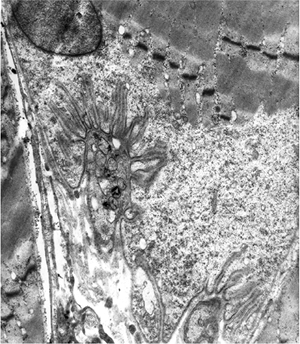 |
Figure 8.3 Electron micrograph of motor endplate (MEP). Ultrastructurally, the MEP consists of a terminal axon and a postsynaptic region formed by a specialized portion of the muscle fiber. The surface of the fiber is undulating, representing the postjunctional folds. |
At the POS region of the muscle fiber, the cell surface is elevated to form the hillock of Doy re, or sole plate. Within the sole plate, the sarcoplasm is granular, and a cluster of sarcolemmal nuclei is often seen. Nuclei in this location are plump and vesicular. The terminal axon ramifies in the sole plate as a series of branches called telodendria, which indent the surface of the fiber, producing gutters or troughs. The surface of the fiber at the MEP is undulating and redundant, creating the complex of postjunctional folds that can be demonstrated by supravital staining as the subneural apparatus of Couteaux. The spaces between the folds denote the secondary synaptic clefts. As a result of the formation of these clefts, the surface area of the POS membrane is increased to approximately 10 times the surface area of the PRS. The postsynaptic membrane of the folds is thicker and more densely stained at the crests than in the depths of the clefts. By electron microscopy, the juxtaneural membrane at the crests of the folds contains irregularly spaced densities measuring 11 to 14 nm in diameter. In freeze-fracture preparations, on the P face of the membrane, the crests are studded with rows of particles that are similar in size to these densities (about 10 nm) (35). These large intramembranous particles are considered to represent the acetylcholine receptor, a pentameric 275 KDa glycoprotein (36).
Light Microscopy
Familiarity with the normal structure of skeletal muscle provides a useful background for the pathologist in the evaluation of muscle biopsies. Other sources offering a more comprehensive discussion of the light microscopy, histochemistry, and electron microscopy of normal muscle than is possible here are found in the literature (37,38,39,40,41,42,43,44,45,46,47,48). The muscle fiber is a multinucleated, syncytial-like unit shaped like a long, narrow cylinder. The normal adult myocyte is not perfectly round but is polygonal, producing a multi-faceted profile in cross section. The nuclei are usually located subsarcolemmally, numbering four to six per cell when sectioned transversely. For each millimeter of fiber length, there are approximately 30 nuclei (49). In routine sections the sarcolemmal nuclei are slender and flat, with an orientation that is parallel to the long axis of the fiber. These nuclei measure 5 to 12 m in length and 1 to 3 m in width. Their chromatin is fine and dustlike. The nucleoli are small and not visible in many fibers. In paraffin sections stained with H&E, the sarcoplasm is light pink and textured in cross sections (Figure 8.4). In frozen sections that are often routine in biopsies submitted for diagnosis, muscle tissue is stained with Gomori's rapid trichrome (RTC). Here the fibers and connective tissue stain green while nuclei are blue-black. In some cases the mitochondria can be identified, especially in
P.201
type 1 fibers, as tiny red granules within the sarcoplasm (Figure 8.5A). The cross-striations must be viewed in longitudinal sections and are difficult to see in any detail without special stains. They are best demonstrated in PAS and PTAH stains or in resin-embedded material where alternating dark and light bands are evident (Figure 8.6). The diameter of fibers is determined by several factors (see the section entitled Gender, Training, and Aging).
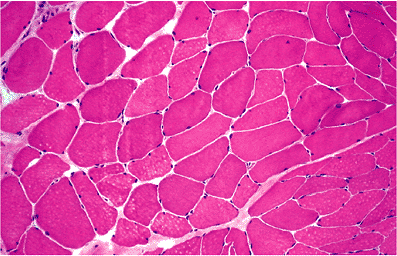 |
Figure 8.4 Cross section of muscle. The sarcoplasm is textured and the sarcolemmal nuclei are peripheral in location (H&E). |
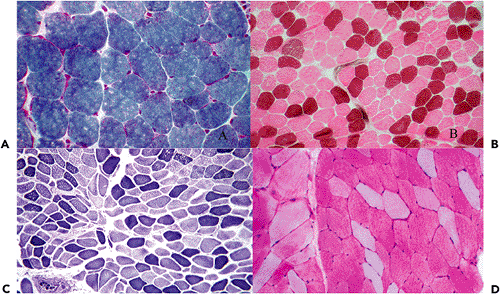 |
Figure 8.5 A. Reverse trichrome stain. Mitochondria appear as red granular areas, especially prominent in the subsarcolemmal regions of the fiber. B. Normal muscle. In the standard ATPase reaction, type 1 fibers are light and type 2 fibers are dark (ATPase, pH9.4, eosin counterstain). C. Normal muscle. In oxidative enzyme reactions, type 1 fibers are very dark, and type 2 fibers are intermediate or light in staining intensity (NADH-TR). D. With PAS stain, variable staining of fibers reflects glycogen content and crudely approximates fiber type distribution (PAS). |
Proximal muscles, where power rather than finely coordinated movement is required, have a fiber population with a larger mean diameter (85 90 m), while those of smaller, distal, and ocular muscles are composed of thinner fibers (20 m). Fiber size in males exceeds that in females, probably in part because of androgenic hormonal influences and more strenuous physical demands. In both genders, exercise promotes fiber hypertrophy. Muscle fibers are smaller in children and in the elderly than in young active adults, although comprehensive normative data at these ages are not easy to find (50,51,52).
Red muscle, having a larger mitochondrial and lipid content and higher capillary density, depends on aerobic respiration and is designed for postural function or sustained activity. The color of red muscles is actually due to relatively greater myoglobin content than white muscles, which contain fewer mitochondria but abundant glycogen, rendering it better suited to anaerobic respiration and to sudden and intermittent contraction. In vertebrates, particularly in birds, red (e.g., soleus) can easily be distinguished from white (e.g., pectoralis) muscles upon external inspection, since an entire muscle in such species may be composed of either red or white fibers. Human muscles, on the other hand, contain both fiber types, which typically assume a mixed mosaic arrangement reminiscent of checkerboard. Depending on anatomic location and function, the proportion of type 1 and type 2 fibers varies, but a typical muscle contains approximately twice as many type 2 fibers (60 65%) as type 1 fibers (35 40%).
The demonstration of the histochemical properties of the muscle fibers comprising a biopsy, which is known as
P.202
fiber typing, is accomplished by applying histochemical techniques (Table 8.1). Fiber typing is not possible in routine H&E-stained slides and is only appreciated in using histoenzymatic reactions performed on frozen sections. In our laboratory, two complementary histochemical procedures are employed for the detection of fiber types. The most reliable method for this purpose is the myofibrillar ATPase reaction. By changing the pH during the procedure, a spectrum of staining reactions can be produced. In the standard or alkaline ATPase reaction, which is conducted at a pH of 9.4, two fiber types are seen. Type 2 fibers are dark in staining intensity, whereas type 1 fibers are pale (Figure 8.5B). Fibers of intermediate staining intensity are not observed in the alkaline incubation.
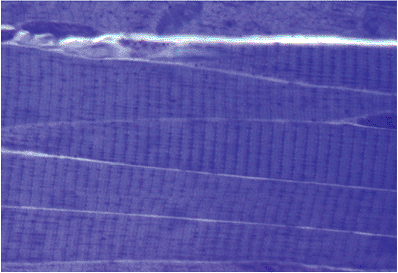 |
Figure 8.6 Resin section. Sarcomere pattern is shown in longitudinal section (toluidine blue). |
Table 8.1 Fiber Typing | |||||||||||||||
|---|---|---|---|---|---|---|---|---|---|---|---|---|---|---|---|
|
If the pH of the incubating solution is brought into the acidic range (pH 4.6) in what is sometimes known as the reverse ATPase reaction, two populations of type 2 fibers emerge. Type 2A fibers are virtually unstained and type 2B fibers are intermediately stained, while type 1 fibers are extremely dark. All the oxidative enzyme reactions, like the NADH-TR used in our laboratory, merely reflect the mitochondrial content of the muscle fibers. Intensely stained fibers are designated as oxidative (type 1) and lighter fibers as type 2 (Figure 8.5C). Most oxidative enzyme reactions further subdivide type 2 fibers into two categories. Type 2B fibers are poorly stained in contrast to type 2A fibers, which exhibit a staining intensity that is intermediate between type 1 and 2B. Although all muscle fibers contain glycogen and the companion enzyme phosphorylase, they are more abundant in type 2 (glycolytic) fibers. The PAS stain, a crude method of detecting glycogen, and the histochemical reaction for phosphorylase can be used as a means of fiber typing (Figure 8.5D). However, staining with these techniques is not totally reliable for fiber typing. We only use the phosphorylase reaction to investigate possible cases of enzyme deficiency (McArdle's disease). Type 1 fibers are rich in lipid, which can be visualized in fat stains such as the oil red O (Figure 8.7); but, like the PAS stain, fat stains are not as reliable for fiber typing as are enzyme reactions.
Striated muscles are partitioned into fascicles, each of which is invested by a connective tissue sheath known as the perimysium. Within this sheath, the intramuscular nerves, primary arteries, secondary and terminal arterioles, and veins travel throughout the muscle. At the innervation zone in the belly of the muscle, intramuscular nerve bundles or twigs are especially numerous (Figure 8.8). Up to 10 myelinated nerve fibers may be present in an individual twig, which is surrounded by a thin mantle of perineurial connective tissue. The myelinated nerve fibers are perhaps best demonstrated in trichrome-stained sections, preferably the RTC, in which the bright red colored myelin sheaths resemble doughnuts surrounding the unstained axons. Tangential sections of twigs may be mistaken for areas of focal fibrosis or abnormal vascular structures. The perimysium is a framework that lends stability to the fascicles, in part by its attachment to the epimysium. The epimysium forms septa that sequester groups of fascicles, as well as the fascia that encircles the entire muscle and merges with the dense collagenous connective tissue of the tendons.
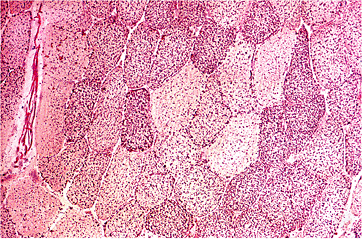 |
Figure 8.7 Lipid content of fibers is demonstrated with oil red O stain. Oxidative fibers have a more dense lipid concentration (oil red O). |
Within each fascicle, the perimysium gives way to a normally unobtrusive network, the endomysium. Each muscle fiber may appear to be partly or completely invested by endomysium, a mesenchymal matrix composed of collagen,
P.203
elastic, and reticulin fibers that support the preterminal arterioles and capillary blood supply to the fascicles. Where the muscle-tendon junction has interdigitations of the cell membrane, the interface is enlarged, transferring tension into shear stress. Two transmembrane proteins, the dystrophin-glycoprotein complex and 7 1 integrin, are especially abundant at the myotendinous junction (53). It is believed that the dystrophin-glycoprotein complex maintains the integrity of the sarcolemma while 7 1 integrin, a receptor for laminin-2, plays a role in the organization of the basement membrane at the myotendinous junction. At the interface between muscle and either fascia or tendon, the muscle fibers become variable, often small in size, and internal nuclei are more abundant. As they attach to the tendon or fascia, the fibers are separated by dense collagenous trabeculae (Figure 8.9). Since the normal histology of these regions may easily be misinterpreted as evidence of pathologic change, the muscle biopsy should be obtained from the belly of the muscle, avoiding the tendinous insertions. A deep rather than a superficial biopsy is preferred to avoid the fascia.
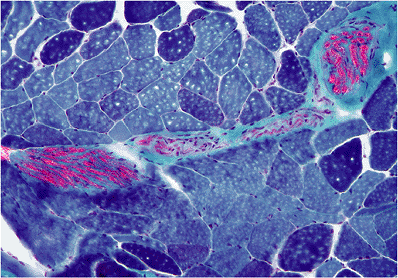 |
Figure 8.8 Intramuscular nerves. Nerve twigs contain axons surrounded by red-staining myelin sheaths (trichrome). |
Several specialized structures are found within the connective tissue supporting framework. Muscle spindles, first described by Hassal and later by Kolliker were once considered to be a pathologic finding (54). Spindles are now known to be mechanoreceptors that sense the length and tension of skeletal muscle, governing integrated muscle activity. Although they are encountered in virtually all muscles, they are more frequently detected in smaller muscles devoted to finely coordinated activities, such as those of the hand. They are more numerous in distal than in girdle muscles. Quantitative studies have shown that 70 to 100 muscle spindles may be located in an individual muscle. Muscle spindles tend to lie in the deeper portions of the muscle, particularly in the muscle belly. They are often found where type 1 fibers are more plentiful.
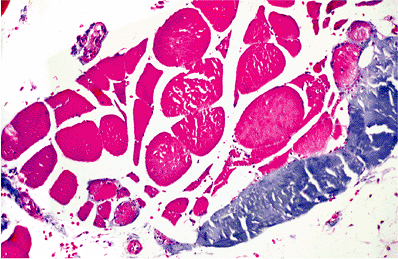 |
Figure 8.9 Tendinous insertion. At the interface, the muscle fibers normally vary in size and are partly surrounded by connective tissue (trichrome). |
As the name implies, muscle spindles are fusiform in shape with a swollen center and tapering ends. They measure 3 to 4 mm in length and 200 m in diameter. A thin fibrous capsule represents the outer boundaries of the muscle spindle. The capsule is an extension of the perimysium, where spindles are usually located. In certain muscles such as those of the eye, face, and mouth, the capsule merges with the perimysium and is somewhat indistinct. The capsule is composed of 10 to 15 layers of flattened pavement cells that are specialized fibroblasts. The pavement cells are tightly adherent and separated only by thin layers of delicate collagen fibrils. The pavement cells are epithelial-like in that each is surrounded by a basement membrane. As one proceeds from the equatorial region of the spindle toward the poles, the number of layers of pavement cells progressively diminishes.
Within the capsule are 3 to 15 intrafusal fibers in the typical muscle spindle (Figure 8.10). Generally the number of intrafusal fibers is less in small muscles than in larger axial muscles. Two distinct populations of intrafusal fibers are found, both of which are smaller in diameter than the extrafusal fibers. The larger bag fibers, usually one to three per spindle, measure about 20 m in diameter. The chain fibers number two to seven per spindle, with a diameter of 10 m or less. The bag fibers are longer, sometimes extending beyond the polar ends of the capsule. They measure 4 to 8 mm in length. The chain fibers are shorter, measuring 2 to 4 mm. The bag fibers are recognized in the equatorial region of the spindle by the presence of large aggregations of nuclei. Away from the equatorial region, the nuclei remain internal or central in the bag fibers but are far less numerous. The smaller chain fibers are distinguished by a row of central nuclei, which extends along the length of the fiber. In histochemical stains, there are two types of bag fibers. Bag 1 fibers reveal considerable oxidative enzyme activity and are pale in ATPase reactions. On the other hand, bag 2 fibers, which also have high oxidative enzyme
P.204
activity, reveal intermediate staining in ATPase reactions. Chain fibers, although they possess high oxidative enzyme activity, stain darkly in ATPase reactions and are considered by many to be type 2 fibers (55).
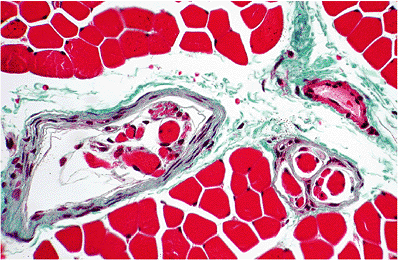 |
Figure 8.10 Muscle spindle. A fibrous capsule encloses a nerve twig and several intrafusal fibers, which are normally smaller than the extrafusal fibers (trichrome). |
The innervation of muscle spindles, which is both motor and sensory, is complex and will only be summarized here (56). The intrafusal efferent fibers are derived from branches of and efferent axons. The axons appear to terminate primarily on nuclear bag fibers. The fibers supply both nuclear bag and chain intrafusal fibers. It is not uncommon for intrafusal fibers to have polyneural innervation. Two types of sensory innervation are seen in the muscle spindle. The larger diameter group Ia afferent fibers emanate from the equator. They originate as the annulospiral endings, a series of neural coils and spirals that attach to the nuclear bag and chain fibers. Smaller diameter group II afferent fibers come from the paraequatorial regions of the spindle and are associated mainly with the so-called flower spray endings of Ruffini. The majority of these endings project from the nuclear chain fibers. The secondary, or flower spray, endings consist of a branching network that enwraps the intrafusal fiber between its polar and equatorial regions.
The Golgi tendon organ is an encapsulated sensory nerve terminal that is located at the junction of muscle with tendon or aponeurosis. The location of these structures allows them to sense changes in muscle tension. They have an inhibitory function in the event of strong muscle contraction. These fusiform structures measure about 1.5 mm in length and 120 m in diameter. They consist of one or more fascicles of collagen fibrils that are attached to tendon or aponeurosis and enveloped by a multilamellar capsule (Figure 8.11). Each structure is connected to 20 to 30 muscle fibers. The Golgi tendon organ is innervated by a myelinated Ib afferent axon, measuring 7 to 15 m in diameter. The afferent nerve typically divides and arborizes around the individual collagen bundles.
Pacinian corpuscles are distributed widely in the subcutaneous tissues of the body, although they may also be encountered within the muscular fascial planes and adjacent to tendons or aponeuroses. They are seldom seen within muscle tissue itself. In the center of the pacinian corpuscle is a central rodlike nerve terminal innervated by fast-conducting group I or II afferent axons. The central axon is surrounded by a capsule composed of concentric layers of cells (Figure 8.12). The elongated cells forming the capsule are surrounded by basal lamina and separated by fine collagen fibrils. Pacinian corpuscles are receptor organs that are sensitive to vibration.
Ultrastructure
The ultrastructural examination of skeletal muscle is conventionally performed on sections oriented longitudinally, wherein deviations from the orderly striated architecture are more easily detected than in cross sections. The sarcoplasm of each muscle fiber is divided into multiple parallel subunits, the myofibrils, which are minute, cylindroid contractile structures measuring approximately 1 m in diameter. Myofibrils are segmented into a series of identical sarcomeres that are equal in length, whether the muscle is contracted or at rest, and are aligned in register with the sarcomeres of surrounding myofibrils. The unique periodicity of the fine structure of the muscle fiber is a function of the regimentation of this contractile system. The rectangular
P.205
banding pattern within each sarcomere is produced by the arrangement of the filaments (Figure 8.13). The Z band, which forms the lateral boundaries of the sarcomere, is an electron-dense bar-shaped structure oriented perpendicular to the long axis of the myofibril. The distance between consecutive Z bands represents the sarcomere length, an average of 2.5 to 3.0 m. The I bands are the most electron-lucent portions of the sarcomere and stand in dramatic contrast to the dark Z bands that bisect them. The I bands are shorter in length than the moderately dense A bands located at the center of the sarcomeres. Within each sarcomere are stacks of parallel filaments that, under the electron microscope, appear to be of two types. The thicker filaments measure 15 nm in diameter and are principally composed of myosin. The thinner filaments, containing chiefly actin, are 8 nm in diameter. The thin filaments are attached to the Z band and extend across the I band, where only thin filaments are found. They penetrate the A band in which alternating thick and thin filaments are visualized. Thick filaments on the other hand, are restricted to the A band region of the sarcomere and determine its length.
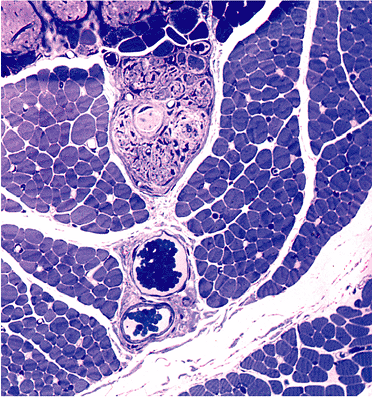 |
Figure 8.11 Golgi tendon organ. Fascicles of collagen surrounded by several nerve bundles (resin section, toluidine blue). |
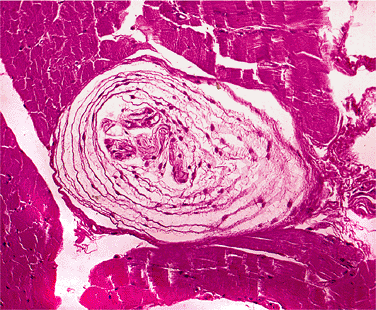 |
Figure 8.12 Pacinian corpuscle. A central nerve terminal is surrounded by a capsule composed of concentric layers of cells (H&E). |
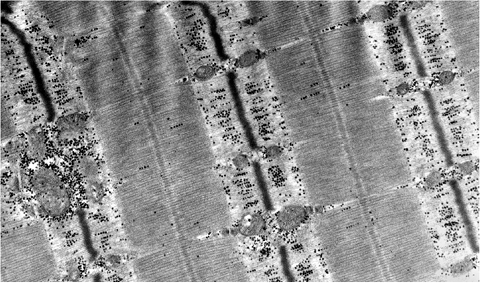 |
Figure 8.13 Ultrastructurally, the several myofibrils can be seen in register. Each is composed of a series of sarcomeres that contain A, I, and Z band regions (EM). |
The sarcoplasmic organelles are more concentrated around the sarcolemmal nuclei and between the myofibrils. The mitochondria are somewhat variable in shape and size, although the majority are oval or elliptical in configuration and 1.0 m in greatest dimension. They are most easily recognized adjacent to the Z bands where their long axes are parallel to those of the myofibrils. Both mitochondria and lipid vacuoles are more conspicuous in oxidative fibers.
Glycogen, composed of granules with a diameter of 15 30 nm, is more abundant in glycolytic fibers, particularly in the I band region of the sarcomere. The sarcoplasmic reticulum (SR) and the transverse (T) tubules together comprise the sarcotubular complex. The SR, which is analogous to the endoplasmic reticulum of other cells, is an elaborate system of tubules that, by branching in all directions, surrounds the myofibrils. In contrast to the SR, which has no communication with the extracellular space, the T tubules arise as invaginations from the cell membrane. They are observed at regular intervals along the length of the fiber, particularly at the junction of the A and I bands. The T tubules encircle the myofibrils and are disposed in a predominantly transverse direction. Branches of the sarcotubular complex join together as triads at the A-I band junctions. Here, pairs of terminal cisterns derived from the SR are positioned on either side of a central T tubule. In this location, the SR tubules appear as hollow, membrane-bound profiles, while the T tubules are somewhat more electron dense.
Satellite cells are a population of myoblastic stem cells that are a source of nuclei during muscle growth, particularly hypertrophy. Satellite cells also have the capacity to synthesize new muscle after myocyte injury. These primitive, indeterminate cells can, under appropriate circumstances, be transformed into blastic elements that serve as an important source of fiber regeneration. Satellite cells represent approximately 10% of the myonuclei seen in cross sections of muscle. There is a decline in the number of satellite cells as a result of the aging process so that they constitute only 2 to 3% of myofiber nuclei in older individuals. Satellite cells are small, mononuclear, fusiform cells that are situated beneath the basement membrane of neighboring muscle fibers (57). They cannot be reliably distinguished from the muscle fiber nuclei under the light microscope. Satellite cells are not randomly distributed along the length of the muscle fiber and are more numerous in certain locations such as the sole plates of the neuromuscular junction and the polar regions of the muscle spindles. Ultrastructurally, the nuclei of satellite cells differ somewhat from the nuclei of muscle fibers. They are more elongated, their nuclear chromatin is peripherally dense, and nucleoli are lacking. The satellite cell nuclei are usually asymmetrical within the cytoplasm, which contains only a few filaments without evidence of sarcomere formation. The sarcoplasm also contains free ribosomes, microtubules, and centrioles, which may be associated with cilia.
P.206
Where the cell membranes of the satellite cell and muscle fiber are opposed, numerous pinocytotic vesicles are seen.
Special Techniques
Perhaps more than any other tissue, skeletal muscle in humans has been studied using a wide variety of specialized techniques, in part because human muscle biopsies are frequently collected in such a way as to make both fresh, unfixed tissue and material for special studies available. In addition to routine histochemical methods that are focused primarily on the identification of fiber types, a number of other histochemical procedures have been employed for the study of both normal and abnormal skeletal muscle. An array of histochemical techniques have been developed to provide greater understanding of muscle metabolism (37,39,40,46). Among these are histochemical techniques to identify various enzymes involved in glycoge metabolism and glycolysis. Familiar examples are histochemical stains for phosphorylase and phosphofructokinase. Other histochemical procedures have been developed to study mitochondrial function. The most widely used is the histochemical stain for cytochrome oxidase. In the workup of human disease, histochemical analysis of muscle tissue can be supplemented by biochemical analysis, specifically when histochemical techniques are unavailable. It is also best, whenever possible, to confirm histochemical findings with biochemical studies. Biochemical analysis has been particularly useful in the study of mitochondrial disease, examining such parameters as the respiratory chain. Molecular techniques are being used with increasing frequency in elucidating normal muscle development as well as muscle disease. A number of abnormal conditions can now be diagnosed using molecular strategies. These include Duchenne dystrophy and other dystrophinopathies (58) and certain mitochondrial disorders in which there is a defect in the mitochondrial genome (59). As mentioned above, it seems likely that the genes that are being discovered in developmental biology one day will contribute to our understanding and diagnosis of muscle disease.
Several techniques have been adapted for the study of intramuscular blood vessels. For example, capillaries are particularly well seen in histochemical procedures for alkaline phosphatase. Capillaries are also nicely demonstrated in immunohistochemical stains for factor VIII.
Immunohistochemistry is an emerging field in pathology that has begun to find a niche in the study of muscle. As already described, muscle fiber typing can be done in frozen sections using histochemical stains such as ATPase. Antibodies to fast and slow myosins are now available for the identification of type 1 and type 2 muscle fibers in fixed tissue (Figure 8.14) (60). It is also possible to subdivide type 2 fibers into types 2A and 2B using myosin antibodies. Fibers undergoing regeneration can be detected by immunohistochemical methods. Regenerating fibers contain fetal myosins and react using antibodies to vimentin and desmin. Recently visualization of the membrane-associated proteins, dystrophin, and the family of sarcoglycans ( - ), has become practical (Figure 8.15). Antibodies to dystrophin, as well as to some of the dystrophin-associated glycoproteins, permit the diagnosis of Duchenne dystrophy, selected other dystrophinopathies, and the some of the limb girdle muscular dystrophies (61). In fact, it is now possible to identify an array of myopathies using immunohistochemistry to study disease-related proteins (Table 8.2).
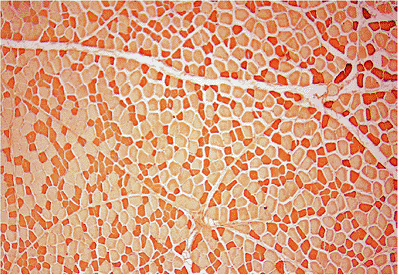 |
Figure 8.14 Checkerboard pattern is seen with dark type 2 fibers and pale type 1 fibers (immunostain for fast myosin). |
The nerve supply to muscle, including the intramuscular nerve twigs and MEPs, cannot be adequately studied in routine samples. The anatomic location of nerve endings and endplates is variable, depending on the muscle selected. They may be restricted to a narrow band across the muscle, or they may be more widely distributed throughout the
P.207
muscle tissue. Some investigators prefer to biopsy shorter muscles, maximizing the chance of finding the intramuscular nerves. The external intercostal muscle has been used for this reason. Many limb muscles have a single band of terminal motor innervation that corresponds to the so-called motor point. The motor point can be identified with the use of an electrical stimulator. After the administration of local anesthesia and incision of the skin, the muscle is stimulated using a metallic electrode before any tissue is removed. The nerve endings can be located at sites where a single fascicle rather than the whole muscle contracts after stimulation with a very weak current. Once the innervation zone is established electrically, the biopsy is removed. Using a variety of techniques, different portions of the muscle innervation can be subsequently evaluated.
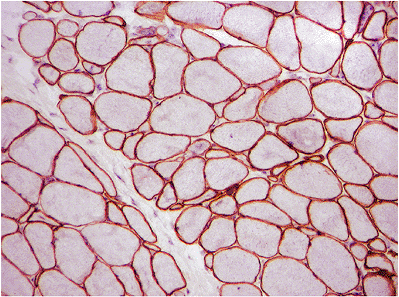 |
Figure 8.15 Sarcolemmal regions are darkly stained (immunostain for dystrophin). |
Table 8.2 Immunohistochemical Identification of Proteins in Skeletal Muscle Disease | ||||||||||||||||||||||
|---|---|---|---|---|---|---|---|---|---|---|---|---|---|---|---|---|---|---|---|---|---|---|
| ||||||||||||||||||||||
Vital staining with methylene blue has been used to demonstrate the intramuscular nerve twigs as well as the endplates (62). This technique requires that the muscle be injected with a methylene blue solution before the muscle sample is actually taken. An undesirable complication of this technique is muscle pain, which many patients experience during the injection of the dye. In order to preserve the staining of the nerve endings, the biopsy must be oxygenated for one hour. This technique is obviously complicated and not recommended for most laboratories. A simpler but less elegant technique for the demonstration of nerve twigs is the staining of muscle with silver methods such as Bodian's stain. The postjunctional portion of the endplate can be stained histochemically for acetylcholinesterase activity (63). The reaction product is not restricted to the postjunctional membrane, and consequently this is a relatively crude method of studying endplates.
More precise methods of studying endplates involve the use of -bungarotoxin and freeze-fracture electron microscopy. Alpha-bungarotoxin is derived from cobra venom and binds specifically with the actelycholine receptor. Immunoperoxidase techniques using -bungarotoxin allow direct ultrastructural visualization of the postjunctional region of the MEP (64). With the use of freeze-fracture preparations, both the active zones of the presynaptic membrane and the acetylcholine receptors of the postsynaptic membrane can be studied in greater detail (65). In certain rare disorders of the neuromuscular junction, freeze-fracture microscopy may be a useful ancillary diagnostic tool.
The nearly crystalline arrangement of filaments within muscle fibers renders them a suitable subject for x-ray diffraction studies. Diffractograms have provided considerable insight into the architecture and structure of the myofilaments (66). A major advantage of x-ray diffraction is its application to living muscle cells. Recently x-ray diffraction has been enhanced by the use of increasingly powerful x-ray sources and electronic signal detectors that have replaced photographic film. Reflection signals from a living muscle fiber can be adjusted to reveal equatorial reflections from the regular lateral spacing of the filaments or meridional reflections originating from the arrangement of subunits in the direction of the fiber axis, depending on the angle of the diffractogram and the camera light.
Finally, morphometric analysis of muscle tissue is indicated in the event that normal or abnormal findings, such as variations in fiber diameters, are minimal and subtle. In the past, morphometry has been performed manually, using an eyepiece micrometer, but this procedure is time-consuming and tedious. More recently, it has been possible to conduct sophisticated morphometric analysis electronically, using a computer-assisted image analyzer (67). Automated image analysis can be adapted for quantitative measurements on photographs of microscopic sections, but systems also exist for totally automated analysis of images taken directly from microscopic slides or other types of tissue preparations.
Function
Muscle has at least two major functions. In addition to the obvious role in locomotion, skeletal muscle is also an important participant in general protein metabolism. The reader will recall that muscles are a significant repository of protein for many systemic metabolic requirements. Protein metabolism depends upon a number of factors in a healthy person. These include the rate of protein synthesis and breakdown, which in turn are determined by diet, hormonal influences, growth, and muscular activity. In general, protein synthesis and degradation are governed by the dietary intake of amino acids.
However, the aspect of muscle function that is most familiar relates to contraction, subsequent movement, and locomotion. It is this aspect of skeletal muscle function on which we will concentrate. When a muscle undergoes
P.208
contraction, it usually exerts force on a movable structure. Isotonic contraction refers to movement that changes the lengths of muscle fibers. If movement does not take place and fiber lengths do not shorten, the contraction is considered to be isometric. The sustained activity of the calf muscles, which do not change length while a person is standing erect, exemplifies isometric contraction. As a rule, a single muscle does not act alone functionally. The coordinated actions of several muscles are usually necessary in the performance of movement. The prime movers are those muscles directly responsible for the desired motion. Antagonists, muscles with opposite action, control the smoothness of the motion. Sometimes agonists and antagonists contract together to stabilize the joint.
An understanding of muscle contraction is predicated on the concept of the motor unit. In simple terms, the motor unit consists of the anterior horn cell that resides in the spinal cord, its motor axon, the intramuscular branches of the main axon (nerve twigs), and the muscle fibers innervated by the twigs. Each motor unit consists of an average of 50 to 100 muscle fibers. The interface between each muscle fiber and its terminal axon is the motor endplate or neuromuscular junction.
There are at least seven critical steps in the process of muscle contraction, each of which will be briefly described (68).
The first step is initiated by the excitation and discharge of the motor neuron or anterior horn cell within the spinal cord. The neuronal discharge is associated with a nerve impulse, or action potential, that is propagated along the axon to its terminal. Nerve conduction is an active process so that the impulse travels along the nerve at a constant amplitude and velocity. The impulse is due to a change in ion concentration across the cell membrane that ultimately depends upon alterations in membrane ion channels. Commensurate with depolarization, the voltage-gated sodium channels open, permitting a massive influx of sodium ions.
It is useful to remember that the neuromuscular junction consists of presynaptic (PRS) and postsynaptic (POS) regions that are separated by a narrow, intercellular synaptic cleft. The process of neuromuscular transmission is heralded by a depolarization of the PRS axon terminal of the motor nerve, which promotes an elevation of intracellular calcium. Calcium ions gain access to the axoplasm through calcium channels in the PRS membrane. In turn, the synaptic vesicles, which contain acetylcholine (ACh), fuse with the axon membrane. This fusion is calcium dependent and leads to a release of ACh into the extracellular space.
Acetylcholine molecules then cross the synaptic cleft and bind to the nicotinic acetylcholine receptors (AChR) on the POS membrane of the muscle fiber. The binding of ACh to the AChR increases the sodium and potassium conductance of the muscle membrane. As a result, there is an influx of sodium ions that is accompanied by a depolarizing potential, representing the endplate potential.
The motor endplate potential is transmitted along the entire muscle fiber surface to initiate the contractile response. Since the T tubules are an extension of the sarcolemma, depolarization spreads along the T tubules, which ramify within the sarcoplasm. Depolarization of the transverse tubular membrane activates the SR by means of the dihydropyridine receptors. These are voltage sensors that respond to the T tubule action potential. They are located next to the calcium channels in the T tubule membranes that trigger the release of calcium from the adjacent SR. Calcium is released from the SR through specific calcium channels known as ryanodine receptors (69).
Once calcium is released from the SR, it rapidly diffuses through the sarcoplasm. Calcium ions initiate contraction by binding to troponin C. In muscle at rest, troponin I is tightly bound to actin so that tropomyosin covers the sites where myosin can bind to actin. This troponin-tropomyosin complex inhibits the interaction between actin and myosin filaments. When calcium ion binds to troponin C, tropomyosin is displaced laterally, uncovering the binding sites for the myosin heads.
The molecular basis of muscle contraction involves the shortening of the contractile elements resulting from a sliding of the thin filaments across the thick filaments. The sliding of actin and myosin filaments occurs when the myosin heads bind to actin to form a crossbridge. X-ray crystallography has revealed that each myosin head has an actin-binding site and an ATP-binding site. The site that binds ATP is cleftlike; but, when ATP is bound and hydrolyzed by ATPase, the conformation of the myosin head changes, and the cleft appears to close. During this conformational change, the rotation of the angle of the crossbridge produces a movement called the power stroke, which advances the myosin filaments along the actin molecules. Every power stroke shortens the muscle approximately 1%. During contraction, numerous power strokes occur each second through crossbridge cycling and involve about 500 myosin heads on each thick filament.
Following contraction, the muscle relaxes as calcium ions are pumped back into the SR and calcium is released from troponin. This inhibits the interaction between actin and myosin.
Muscle is sometimes conceptualized as machinery that converts chemical energy into mechanical work. Muscle contraction requires large amounts of energy, which is derived from the intermediary metabolism of lipids and carbohydrates. The metabolism of these energy sources, which lead to the production of ATP, is beyond the scope of this chapter.
P.209
Gender, Training, and Aging
Some of the earliest studies addressing differences between males and females with regard to muscle fiber size and composition were conducted by Brooke and his colleagues (70). In a seminal study of the biceps muscle in six patients, they established certain principles which remain generally true concerning gender differences in skeletal muscle. Individual muscle fibers are larger in males than in females for several reasons. Explanations include the fact that males are generally bigger than females, being taller and heavier, with a larger muscle mass for body size. Males are also more active and frequently engage in more strenuous physical exertion. Androgens are also thought to play a role in the size of muscle fibers in males, since it is known that testosterone supplements produce muscle fiber hypertrophy. In males, type 2 fibers are usually larger than type 1 fibers, in contrast to females where type 1 fibers tend to be of equal or greater diameter. An excellent summary of this subject was published by Bennington (67) who showed that some of the differences between males and females are dependent upon the muscles sampled. For example, studies of the biceps muscle essentially verify the findings of Brooke et al. However, examination of the vastus lateralis indicates no significant difference in diameter between type 1 and type 2 fibers in males. Another interesting conclusion from these studies addresses the question of fiber type predominance in the two sexes. With regard to the biceps muscle, males have a much higher percentage of type 2 fibers, whereas females have almost equal numbers of each. On the other hand, in the vastus lateralis, both males and females have similar proportions of type 1 and type 2 fibers.
The effect of exercise and training on skeletal muscle has been examined in a host of investigations over the past 25 years. The results of many of these studies are conflicting, but certain general principles have emerged. It is clear that exercise and training of any type causes an increase in muscle fiber diameters. Activities that are basically anaerobic in nature promote hypertrophy of type 2 fibers, a common finding in sprinters. In long distance runners, for whom aerobic metabolism is more important, type 1 fibers tend to be larger. Most authorities agree that power training such as weight lifting results in remarkable hypertrophy of type 2 fibers and less, if any, enlargement of type 1 fibers.
A more controversial topic is whether there is a change in fiber type composition after long periods of training. It is well known that sprinters tend to have larger numbers of type 2 fibers than sedentary controls and long distance runners tend to have more type 1 fibers than untrained counterparts. Many investigators tend to believe that these two groups of runners have genetically determined fiber type composition and little, if any, conversion of fiber types takes place during training. However, some studies have shown that while conversion from type 1 to type 2 fibers probably does not occur, certain activities such as endurance running may be responsible for the conversion of type 2B to type 2A fibers over prolonged periods of time (71). Animal studies have shed minimal light on these questions, in part because animal muscle responds differently to exercise and training than does human muscle. In fact, animal experiments have more often clouded the issues of exercise and fiber composition instead of resolving the controversy.
During the process of aging, there is a functional and structural decline in skeletal muscle beginning in the sixth decade and accelerating after the age of 70 years (72). By the age of 75 years, there is a 30 to 50% decline in muscle strength, the cause of which is complex. Because of the alterations in the composition of their connective tissues, associated with decreased elasticity and flexibility, and because many older patients have joint disease of varying severity, the elderly become less active with a corresponding reduction in muscle volume and contractile strength. Some experts view this condition as a form of disuse. Their conclusions are supported by the fact that aging individuals, like young patients who do not use their muscles (for example, as a result of immobilization in a cast), have selective atrophy of type 2 fibers (Figure 8.16). The effect of poor nutrition in the elderly has not been extensively studied, although it is well known that cachexia is also accompanied by atrophy of type 2 fibers.
A second problem in the elderly population is an insidious damage to the motor units, specifically to the anterior horn cells in the spinal cord. It has repeatedly been shown that with advancing age there is a progressive loss of anterior horn cells. Due to degenerative spine disease, there is also injury to nerve roots, with subsequent radiculopathy. The integrity of the muscle fiber is closely related to the maintenance of its nerve supply. Any sustained interruption of trophic influences from the motor neuron or nerve will culminate in atrophy of the denervated muscle fiber. In acutely denervated muscle, randomly distributed small fibers are seen. When sectioned transversely, atrophic fibers
P.210
are characteristically angular or ensate. They appear flattened and bipolar with tapering ends. Most or all of the atrophic fibers are dark in alkaline ATPase reactions and are of glycolytic type. At this stage, selective atrophy of type 2 fibers is commonly the only pathologic abnormality, so that the proper diagnosis of denervation requires corroborative clinical information. With progressive denervation, the proportion of atrophic type 1 and type 2 fibers tends to equalize. As long as atrophic fibers remain scattered and are not yet grouped together, from a diagnostic perspective, the pattern of atrophy is nonspecific.
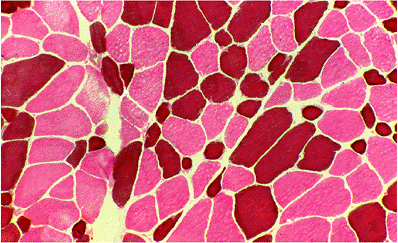 |
Figure 8.16 Type 2 fiber atrophy (ATPase, pH 9.4, eosin counterstain). |
The esterase stain is very useful under these circumstances because denervated fibers are extremely dark in esterase preparations, whereas atrophic fibers in other conditions are not. Atrophic fibers are also excessively dark in oxidative enzyme reactions, but such staining applies to fiber atrophy of almost any cause. Small dark fibers are probably explained by the fact that mitochondria are relatively spared in the atrophic process and occupy a proportionately greater volume of sarcoplasm. The affinity of atrophic fibers for oxidative enzyme stains means that the ATPase reaction is preferable for accurate fiber typing of small fibers, no matter what the pathogenesis of fiber atrophy is.
Prima facie evidence of advanced denervation is a progression from random fiber atrophy to grouped atrophy in which multiple collections of small, angular or ensate fibers are present in the biopsy sample (Figure 8.17). As a consequence of chronic denervation and of reinnervation (73), the normal checkerboard staining profile observed in histoenzymatic reactions is effaced. In an effort to reestablish the nerve supply to denervated muscle fibers, intact intramuscular nerves undergo collateral sprouting, and new synapses are formed with atrophic fibers. As motor units enlarge, reinnervated fibers occupying a large area are converted to one histochemical type. The phenomenon of type grouping (Figure 8.18) is explained by the fact that all muscle fibers within a single motor unit are of the same type either type 1 or type 2 and the motor neuron, through the trophic influences of its axon and collaterals, governs the histochemical properties of its fibers. The plasticity of muscle fibers allows conversion from one histochemical type to the other when there is reinnervation by a motor neuron of the opposite type. Along with type grouping, target fibers are pathognomic of denervation (74).
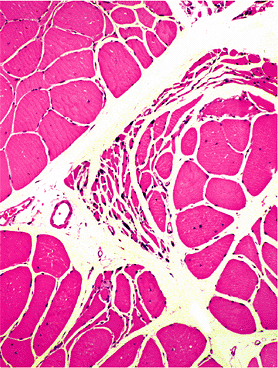 |
Figure 8.17 Grouped atrophy (H&E). |
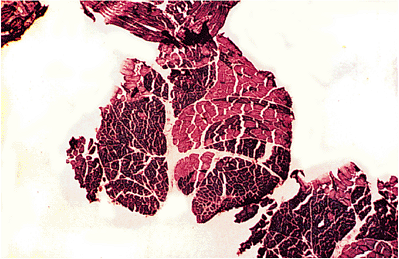 |
Figure 8.18 Chronic denervation with reinnervation. Type grouping has altered the normal checkerboard staining profile (NADH-TR). |
Despite their unique specificity, regrettably bone fide target fibers are present in less than 25% of cases of neurogenic atrophy. Although targets and cores are similar morphologically, they differ in three ways. While both tend to occur singly within a fiber, the target is larger in diameter. The target is limited in length, only extending across a few sarcomeres, in contrast to the core, which may run the entire length of the fiber. Most important is the three-zone architecture of the target fiber (Figure 8.19). The central zone, indistinguishable at the ultrastructural level from the unstructured core, is surrounded by an intermediate zone that forms an intensely stained rim in oxidative enzyme reactions. By definition, the intermediate zone, difficult to identify in most other stains, is absent from a core. It is a zone of transition between the central zone of severe sarcoplasmic disruption and the third zone, which represents the normal portion of the muscle fiber. Targetoid fibers, which lack the intermediate zone of increased oxidative enzyme activity, are morphologically identical to core fibers. The term core is conventionally used in cases of congenital central core disease, and the term targetoid is applied to cores that are found in any other condition. In our experience, targetoid fibers are more commonly encountered in neurogenic atrophy than any other condition and are more frequently seen than target fibers.
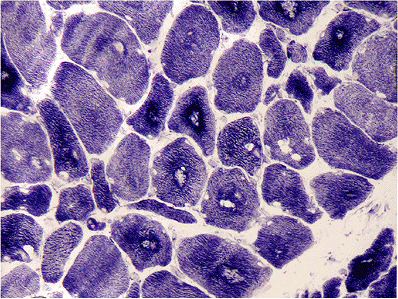 |
Figure 8.19 Neurogenic atrophy. Target fibers have an inner, unstained zone surrounded by a rim of increased enzyme activity (NADH-TR). |
P.211
Artifacts
The most common artifacts are related to unsuspected or inadvertent injury to the muscle specimen, irreverent handling at the time of removal, or to improper tissue sectioning and staining. When they are linear in configuration, needle tracts, such as those produced during electromyography (EMG) studies, may easily be recognized. More often, needle tracts are cut tangentially so that the pathologist may be misled by a histologic picture of myopathy exemplified by fiber necrosis, regeneration, inflammation, and interstitial fibrosis (Figure 8.20). This kind of artifact is generally traceable to poor communication between the physician requesting the biopsy and the individual performing the procedure, who is unaware of the previous intramuscular injections.
Large numbers of neutrophils are occasionally observed within the intramuscular blood vessels. Typically, these cells are marginated and may have begun to penetrate the vascular walls and enter the perimysium or endomysium. In the absence of other pathologic changes within the specimen, the presence of neutrophils usually means that the muscle has been crushed during the biopsy procedure or it has been infiltrated with anesthetic agent.
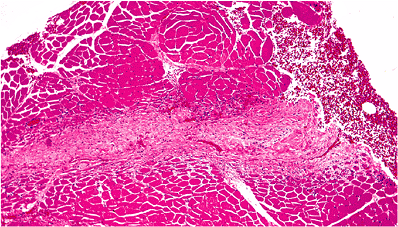 |
Figure 8.20 Needle tract. Area of injury contains necrotic fibers and a small focus of lymphocytic inflammation (H&E). |
 |
Figure 8.21 Vacuolar artifact. Improper freezing has caused numerous clear holes to form within the fibers (NADH-TR). |
Even with the best technical expertise available, muscle tissue is sufficiently fragile that most laboratories find vacuolization of muscle fibers produced during freezing is unavoidable in 10 to 20% of specimens. Vacuolization can be minimized by using proper techniques that permit rapid freezing and by proper specimen storage to prevent thawing. Mild vacuolar artifacts may be tolerable, but large vacuoles that disrupt the sarcoplasm are especially troublesome (Figure 8.21). Larger vacuoles may interfere with accurate biopsy interpretation by distorting the pathologic changes in the sample or by simulating the picture of vacuolar myopathy, such as glycogen or lipid storage disease.
Muscle that is unprotected by isometric clamping is vulnerable to contraction artifact. During uncontrolled contraction, a series of segmental contractions occur along the length of the muscle fiber as the contractile elements are pulled beyond the confines of their respective sarcomeres. This phenomenon is best observed in longitudinal sections where dark hypercontracted regions are punctuated by pale, ghostlike zones of myofibrillar disruption (Figure 8.22). In transverse orientation, these disrupted segments are seen as irregular fissures in the sarcoplasm. Contraction artifact is particularly undesirable when electron microscopic studies are needed, even if the artifact is subtle and cannot be appreciated at the light microscopic level. The detection of ultrastructural abnormalities, which is dependent on the normal alignment of the myofibrils and myofilaments, is compromised by the distortion of sarcomeric structures. Tissue within the teeth of the clamp is sometimes submitted for processing. This tissue, if not entirely crushed and easily recognized as such, may be compressed, producing an artifact that looks like fiber atrophy. A clue to artifact is the difference in fiber diameters in the rest of the biopsy specimen and the clamped fibers, all of which are uniformly small and angular.
 |
Figure 8.22 Contraction artifact. Dark contraction bands and lucent zones of fiber disruption are seen in longitudinally oriented fibers (H&E). |
P.212
Dark staining of the sarcoplasm in random fibers is often due to variations in section thickness. Fibers adjacent to the connective tissue of the perimysium are especially susceptible to this artifact. Inconsistencies of section thickness may be recognized when linear, bandlike regions of intense staining are visible within muscle fibers. Excessively pale histochemical reactions can result from the degradation of enzyme systems in the sarcoplasm. Artifacts are distinguished from legitimate abnormal staining if all histochemical reactions in the biopsy are pale. In our experience, this artifact is most often attributable to delayed freezing of the specimen because of a delay in transport. Laboratories that accept consultation specimens from institutions other than their own should be aware of this problem in order to reduce the time required for transportation.
Another transportation-related artifact is seen in specimens shipped in ice when the ice melts, leaving the exposed fresh tissue floating in water. This situation results in a disfiguring and distracting artifact in frozen sections stained with RTC. The normal green staining of the tissue is distorted by irregular red-stained areas that interfere with interpretation of a biopsy (Figure 8.23).
 |
Figure 8.23 Exposure of fresh muscle to water during transport may cause an abnormal staining pattern in RTC, obscuring the detail and granular appearance of mitochondria (RTC). |
Differential Diagnosis
Several findings in skeletal muscle biopsies are normal or are minor variations that may be mistaken for pathologic change. These include internal nuclei, ring fibers, hyalin fibers, excessive endomysial connective tissue, perivascular inflammation, variations in fiber diameters, and ragged red fibers.
One of the most common pathological abnormalities in muscle biopsies is nuclear internalization (Figure 8.24). Quantitative analyses have demonstrated that the nuclei are peripherally located in 97 to 99% of normal muscle fibers, which means that up to 3% of fibers with internal nuclei is a normal finding. In many different conditions, an increase in internal nuclei is found, typically affecting 5 to 10% of fibers and particularly those that are mildly atrophic. Nuclear internalization has no specific diagnostic significance and appears to be a reaction to virtually any type of injury. The diagnosis of myotonic dystrophy should be strongly considered if the majority of fibers contain internal nuclei.
One must exercise caution in interpreting the significance of ring fibers in specimens disrupted by contraction artifact because, in this situation, ring fibers are not a genuine pathologic change. In properly processed, uncontracted muscle biopsies, ring fibers are a pathologic criterion of myotonic disorders. The ring is formed by a bundle of peripheral myofibrils that are circumferentially oriented such that they encircle the internal portion of the sarcoplasm, which is normal in structure and orientation. In cross sections of muscle, the ring is especially well visualized in PAS stains where the striations of the transversely oriented peripheral myofibrils are seen in contrast to the inner sarcoplasmic contents (Figure 8.25). Rings are also seen to advantage in PTAH stains, resin sections, or under phase contrast microscopy. Under the electron microscope,
P.213
the pathologically oriented myofibrils are generally normal in structure except for hypercontraction of the sarcomeres (75).
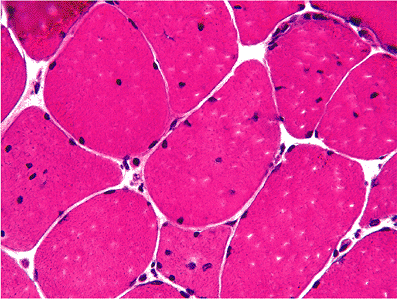 |
Figure 8.24 Nuclear internalization. Several fibers contain internal pyknotic nuclei, a common nonspecific pathologic change (H&E). |
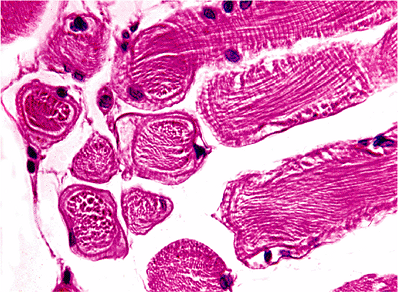 |
Figure 8.25 Ring fibers. Bundles of myofibrils are circumferentially oriented, forming rings that encircle transversely sectioned fibers. (PAS). |
Along with ring fibers, hyalin fibers are evident in specimens damaged by contraction artifact. These fibers are abnormally increased in diameter and rounded in configuration. Their sarcoplasm in both paraffin and frozen sections is smudged or glassy and more deeply stained than in normal fibers (Figure 8.26). The hyalin appearance is the legacy of hypercontraction, as shown in electron microscopic studies. In clamped specimens that are free of excessive contraction, true hyalin fibers are a common feature of Duchenne muscular dystrophy. The pathogenesis of true hyalin fiber formation, which is believed to precede subsequent fiber necrosis (76), is apparently related to excessive irritability secondary to cell membrane instability. It is possible that sarcolemmal damage allows excessive contraction and also promotes cell necrosis. In serial sections of hyalin fibers, areas of necrosis may be found, indicating the importance of hyalinization as a sign of fiber destruction.
 |
Figure 8.26 Hyalin fibers. Several fibers are enlarged, rounded, with darkly stained sarcoplasm. (H&E). |
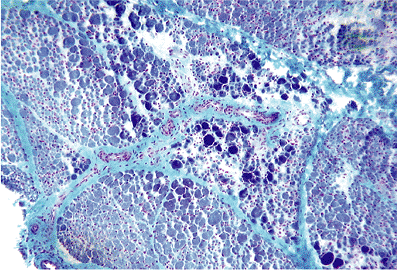 |
Figure 8.27 Infant muscle. A relative increase in perimysial connective tissue is normal (trichrome). |
Excessive quantities of endomysial connective tissue usually represent reactive fibrosis accompanying neuromuscular disease. However, as pointed out above, at the interface between muscle and tendons or fascia, abundant connective tissue is normally present and should not be regarded as reactive fibrosis. Although endomysial connective tissue is not prominent in the biopsies of infants, as indicated previously, the perimysial connective tissue far exceeds the amount present in older children and adults (Figure 8.27).
Interstitial and perivascular inflammatory cells almost always reflect clinical disease, most frequently immunologically mediated or idiopathic inflammatory myopathies such as polymyositis or dermatomyositis. However, in the biopsies of infants it is well to remember that small foci of hematopoiesis are normally present and do not represent true inflammatory infiltrates. Muscles subjected to trauma such as EMG needles may harbor foci of inflammation for months following the diagnostic study and are not clinically significant.
One of the most demanding challenges to the diagnostic pathologist is the muscle biopsy characterized by a variation in fiber diameters or by what appears to be atrophy or hypertrophy. The utility of enzyme histochemistry in these situations cannot be overstated. It is important to recall from previous discussions that (a) a normal variation in fiber size occurs at the junctions of muscle fibers and either tendons or fascia and (b) what at first seems to be atrophy may be normal, depending upon the muscle examined and upon the patient's age and sex. Smaller muscles, and especially those devoted to finely coordinated activities, have much smaller diameters than large, bulky muscles. Muscle fibers are expected to be much smaller in infants and children than in mature adults; and, as previously noted, there
P.214
is an increasing reduction in fiber diameters with advancing age. The significance of fiber hypertrophy should be evaluated in light of the patient's activity and level of regular exercise. In evaluating fiber size, it may be necessary to measure fiber diameters.
Morphometric analysis of the muscle biopsy is imperative when the changes in fiber diameters are minimal and subtle. In order to obtain statically significant morphometric data, the lesser diameter of each muscle fiber should be determined, based upon a minimum number of 200 fibers in the sample (77). The atrophic or hypertrophic process may be selective, affecting only one fiber type, or it may be nonselective (78). True selective atrophy of type 1 fibers is most commonly encountered in myotonic dystrophy. Type 2 fiber atrophy is a common finding in acute denervation, disuse, and myasthenia gravis. True hypertrophy of type 1 fibers is relatively specific for infantile spinal muscular atrophy. True type 2 fiber hypertrophy is generally restricted to congenital fiber-type disproportion. The pattern of atrophy is important in distinguishing between normal and abnormal. Randomly distributed small or large fibers may be normal, depending on other factors discussed above. Grouped atrophy, where five or more small angular fibers cluster together is essentially diagnostic of chronic neurogenic disease. Panfascicular atrophy, in which the majority of fibers in each fascicle are atrophic, is virtually specific for infantile spinal muscle atrophy. Perifascicular atrophy is typical of dermatomyositis.
Ragged red fibers can be observed in elderly people (79). These fibers are recognized in RTC stains performed on frozen sections, where they exhibit an irregular surface and collections of red staining subsarcolemmal material (Figure 8.28). The ragged red areas represent foci of increased, often abnormal mitochondria. Ragged red fibers are generally the hallmark of the mitochondrial myopathies, which are characterized by mitochondrial dysfunction and often mutations of mitochondrial genes (41). It is now known that mitochondrial damage occurs in the aging cell, including skeletal muscle. Ragged red fibers are considered to be a reflection of this damage, which may be associated with clinical disease but frequently is not.
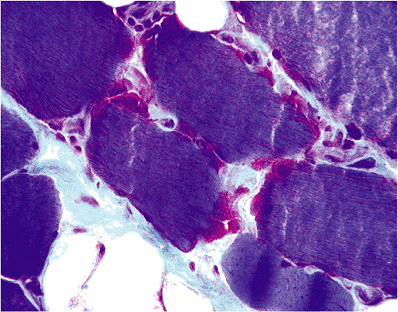 |
Figure 8.28 Ragged red fibers. Ragged red fibers are recognized in RTC stain as having an irregular sarcolemmal surface with collections of red-staining material (RTC). |
Specimen Handling
Muscle biopsies should be performed by physicians with expertise in biopsy technique and a sincere interest in obtaining the best possible specimen. The physician who has direct responsibility for the patient's care needs to be sure that the biopsy comes from an appropriate muscle so that it is representative of the disease process. In some conditions, the disease process is widespread, such as in many metabolic diseases, and virtually any muscle is suitable for biopsy. However, in other disorders where, for example, symptoms are referable to the legs and spare the arms, a biopsy of the deltoid or biceps brachii muscle is unlikely to reflect the disease process accurately and may be normal or nondiagnostic. Moreover, whenever possible, the tissue sample should be obtained from a region in which the disease process remains active rather than quiescent. In a muscle where the disease process has subsided, the biopsy is apt to be unremarkable. In severely involved muscle, particularly if there is marked weakness or wasting, the pathologic findings are likely to be those of end-stage disease which may defy conclusive pathologic interpretation. Muscles subjected to previous traumatic injury, such as needle tracts incurred during EMG or intramuscular injections of medications, and muscles altered by an unrelated disease process should not be biopsied. The pathologic picture in such muscles may simulate that associated with a variety of neuromuscular diseases and will confuse the pathologist.
The special handling of the muscle biopsy precludes submission of the specimen on weekends and holidays or late in the workday afternoon when laboratory personnel are not available to receive and process the tissue. If possible, a technician familiar with the biopsy technique should assist the physician performing the biopsy and collect the specimen properly. Two separate specimens from the same site are routinely required. The first specimen is maintained at isometric length by its insertion in a muscle clamp. This device is designed to minimize contraction artifact, which inevitably results when an incision is made in the muscle, and it is immersed in fixative. Since the muscle is introduced into the instrument lengthwise, the sample is conveniently oriented for further processing. The biopsy must extend entirely across the clamp, thereby ensuring an acceptable specimen size of at least 1 cm in length. The biopsy should be of sufficient size to maximize the opportunity of observing the entire pathologic process. To
P.215
attain this goal, some clinicians favor obtaining two biopsies routinely, one from the arm and one from the leg, for example. Thus, the major drawback to needle biopsy, which has certain advantages over open biopsy, is the limited size of the sample.
While there is some disagreement regarding the primary fixative for muscle biopsies, we have elected to use 10% formalin, buffered to a pH of 7.4 in a 0.1 M phosphate buffer. Strips of muscle 1 mm in width are dissected from the edges of the sample and postfixed in phosphate-buffered 2% glutaraldehyde for electron microscopic study. After fixation for a minimum of 24 hours in 10% phosphate-buffered formalin, the remainder of the sampled specimen is used for routine paraffin sections. A second unfixed specimen measuring 1 0.5 0.5 cm is obtained for the preparation of frozen sections. Although the utilization of a muscle clamp is not mandatory, clamping the specimen will help in its orientation.
Several techniques are described for flash freezing (80), but we prefer freezing the sample in liquid nitrogen after coating the surface of the specimen with talc. Whatever technique is employed, the condition on which the freezing technique is based is that it proceeds with extreme rapidity, within 10 to 15 seconds. Freezing the tissue in a cryostat in a fashion similar to most specimens submitted for frozen section diagnosis from the operating room is contraindicated. The frozen sample should be oriented so that cross sections of muscle are cut. Serial frozen sections in our laboratory are stained with H&E, rapid Gomori's trichrome (RTC), and three standard histochemical reactions: ATPase (pH 9.4 and 4.6) and NADH-TR. Other stains such as periodic acid-Schiff (PAS) for glycogen, phosphorylase, and fat stains are performed when indicated. Frozen tissue may also be used for biochemical analysis, for immunohistochemical preparations, and for immunofluorescence microscopy. Inasmuch as frozen tissue may be needed for future additional studies, muscle biopsies can be sealed in airtight plastic capsules or bags to prevent dessication and freezing artifact while stored in an ultralow freezer at 70 C.
References
1. Jacob M, Christ B, Jacob HJ. On the migration of myogenic stem cells into the prospective wing region of chick embryos. A scanning and transmission electron microscope study. Anat Embryol (Berl) 1978;153:179 193.
2. Larsen WJ. Human Embryology. New York: Churchill Livingstone; 1993:281 307.
3. Okazaki K, Holtzer H. Myogenesis: fusion, myosin synthesis, and the mitotic cycle. Proc Natl Acad Sci U S A 1966;56:1484 1490.
4. Yaffe D. Developmental changes preceding cell fusion during muscle differentiation in vitro. Exp Cell Res 1971;66:33 48.
5. Wakshull E, Bayne EK, Chiquet M, Fambrough DM. Characterization of a plasma membrane glycoprotein common to myoblasts, skeletal muscle satellite cells, and glia. Dev Biol 1983;100:464 477.
6. Keeter JS, Pappas GD, Model PG. Inter- and intramyotomal gap junctions in the axolotl embryo. Dev Biol 1975;45:21 33.
7. Chiquet M, Eppenberger HM, Turner DC. Muscle morphogenesis: evidence for an organizing function of exogenous fibronectin. Dev Biol 1981;88:220 235.
8. Kelly AM, Zacks SI. The histogenesis of rat intercostal muscle. J Cell Biol 1969;42:135 153.
9. Ishikawa H, Bischoff R, Holtzer H. Mitosis and intermediate-sized filaments in developing skeletal muscle. J Cell Biol 1968;38:538 555.
10. Franklin GI, Yasin R, Hughes BP, Thompson EJ. Acetylcholine receptors in cultured human muscle cells. J Neurol Sci 1980;47:317 327.
11. Martin L, Joris C. Histoenzymological and semiquantitative study of the maturation of the human muscle fiber. In: Walton JN, Canal N, Scarlato G, eds. Disease of Muscle. Amsterdam: Excerpta Medica; 1970:657.
12. Wohlfart G. Ueber das vorkommen verschiedener arten von muskelfarsern in der skelettmusculatur der menschen und einiger saugetiere. Acta Psychiatr Neurol 1937;12(suppl):119.
13. Fenichel GM. A histochemical study of developing human skeletal muscle. Neurology 1966;16:741 745.
14. Carlson BM. Human Embryology and Developmental Biology. Philadelphia: Mosby; 2005.
15. Goldspink G. Sarcomere length during post-natal growth of mammalian muscle fibers. J Cell Sci 1968;3:539 548.
16. Close RI. Dynamic properties of mammalian skeletal muscles. Physiol Rev 1972;52:129 197.
17. Goldspink G. Postembryonic growth and differentiation of striated muscle. In: Bourne GH, ed. The Structure and Function of Muscle. Vol. 1. New York: Academic Press; 1972:179 236.
18. Stickland NC. Muscle development in the human fetus as exemplified by m. sartorius. J Anat 1981;132(pt 4):557 579.
19. Adams RD, DeReuck J. Metrics of muscle. In: Kakulas BA, ed. Basic Research in Myology. Amsterdam: Exerpta Medica; 1972.
20. Kakulas BA, Adams RD. Embryology and histology of skeletal muscle. Diseases of Muscle. Pathological Foundations of Clinical Myology. 4th ed. Philadelphia: Harper and Row; 1985:8 9.
21. Adhihetty PJ, Hood DA. Mechanisms of apoptosis in skeletal muscle. Basic Appl Myol 2003;13:171 179.
22. Hamburger V. History of the discovery of neuronal death in embryos. J Neurobiol 1992; 23:1116 1123.
23. Sohal GS. Sixth Annual Stuart Reiner Memorial Lecture: embryonic development of nerve and muscle. Muscle Nerve 1995;18:2 14.
24. McClearn D, Medville R, Noden D. Muscle cell death during the development of head and neck muscles in the chick embryo. Dev Dyn 1995;202:365 377.
25. Abood EA, Jones MM. Macrophages in developing mammalian skeletal muscle: evidence for muscle fiber death as a normal developmental event. Acta Anat 1991;140:201 212.
26. Fidzianska A, Goebel HH. Human ontogenesis. 3. Cell death in fetal muscle. Acta Neuropathol (Berl) 1991;81:572 577.
27. MacKenzie WC. The Action of Muscles, Including Muscle Rest and Muscle Re-education. New York: Hoeber; 1921.
28. Feinstein B, Lindeg rd B, Nyman E, Wohlfart G. Morphological studies of motor units in normal human muscles. Acta Anat 1955;23:127 142.
29. Clemente CD, ed. Gray's Anatomy. 30th Amer. ed. Philadelphia: Lea and Febiger; 1985:434 436.
30. Blomfield LB. Intramuscular vascular patterns in man. Proc Roy Soc Med 1945;38:617 618.
31. Renkin EM, Hudlicka O, Sheehan RM. Influence of metabolic vasodilatation on blood-tissue diffusion in skeletal muscle. Am J Physiol 1966;211:87 98.
32. Emslie-Smith AM, Engel AG. Microvascular changes in early and advanced dermatomyositis: a quantitative study. Ann Neurol 1990;27:343 356.
33. Schmalbruch H. Rote muskelfasern. Z Zellforsch Mikrosk Anat 1971;119:120 146.
34. Heuser JE, Reese TS, Landis DM. Functional changes in frog neuromuscular junctions studied with freeze-fracture. J Neurocytol 1974;3:109 131.
P.216
35. Ellisman MH, Rash JE, Staehelin LA, Porter KR. Studies of excitable membranes. II. A comparison of specializations at neuromuscular junctions and nonjunctional sarcolemmas of mammalian fast and slow twitch muscle fibers. J Cell Biol 1976;68:752 774.
36. Ross MJ, Klymkowsky MW, Agard DA, Stroud RM. Structural studies of a membrane-bound acetylcholine receptor from Torpedo californica. J Mol Biol 1977;116:635 659.
37. Carpenter S, Karpati G. Pathology of Skeletal Muscle. New York: Churchill Livingstone; 1984.
38. DeGirolami U, Smith TW. Teaching monograph: pathology of skeletal muscle diseases. Am J Pathol 1982;107:231 276.
39. Dubowitz V, Brooke MH. Muscle Biopsy. A Modern Approach. Philadelphia: WB Saunders; 1973.
40. Engel AG, Franzini-Armstrong C, eds. Myology. 2nd ed. New York: McGraw-Hill; 1994.
41. Heffner RR, ed. Muscle Pathology. New York: Churchill Livingstone; 1984.
42. Heffner RR Jr. Muscle biopsy in the diagnosis of neuromuscular disease. Semin Diagn Pathol 1984;1:114 151.
43. Heffner RR Jr, Balos LL. Muscle biopsy in neuromuscular diseases. In: Mills SE, ed. Sternberg's Diagnostic Surgical Pathology. Vol. 1. 4th ed. Philadelphia: Lippincott Williams & Wilkins; 2004:111 135.
44. Kakulas BA, Adams RD. Diseases of Muscle. Pathological Foundations of Clinical Myology. 4th ed. Philadelphia: Harper & Row; 1985.
45. Karpati G, ed. Structural and Molecular Basis of Skeletal Muscle Diseases. Basel: ISN Neuropathology Press; 2002.
46. Mastaglia FL, Walton JN, eds. Skeletal Muscle Pathology. 2nd ed. Edinburg: Churchill Livingstone; 1992.
47. Pearson CM, Mostofi FK, eds. The Striated Muscle. Baltimore: Williams & Wilkins; 1973.
48. Swash M, Schwartz MS. Neuromuscular Diseases. A Practical Approach to Diagnosis and Management. New York: Springer-Verlag; 1981.
49. Schmalbruch H. Muscle fibers as members of motor units. Skeletal Muscle. Berlin: Springer-Verlag; 1985:301.
50. Brooke MH, Engel WK. The histographic analysis of human muscle biopsies with regard to fiber types. 4. Children's biopsies. Neurology 1969;19:591 605.
51. Bowden DH, Goyer RA. The size of muscle fibers in infants and children. Arch Pathol 1960;69:188 189.
52. Vogler C, Bove KE. Morphology of skeletal muscle in children. An assessment of normal growth and differentiation. Arch Pathol Lab Med 1985;109:238 242.
53. Miosge N, Klenczar C, Herken R, Willem M, Mayer U. Organization of the myotendinous junction is dependent on the presence of 7 1 integrin. Lab Invest 1999;79:1591 1599.
54. Kolliker A. Mikroskopische Antomie odor Gewebelehre des Menschen. Leipzig: Engelmann; 1850:253 255.
55. Bakker GJ, Richmond FJ. Two types of muscle spindles in cat neck muscles: a histochemical study of intrafusal fiber composition. J Neurophysiol 1981;45:973 986.
56. Swash M, Fox KP. Muscle spindle innervation in man. J Anat 1972;112(pt 1):61 80.
57. Campion DR. The muscle satellite cell: a review. Int Rev Cytol 1984;87:225 251.
58. Hoffman EP, Wang J. Duchenne-Becker muscular dystrophy and the nondystrophic myotonias. Paradigms for loss of function and change of function of gene products. Arch Neurol 1993;50:1227 1237.
59. Johns DR. Mitochondrial DNA and disease. N Engl J Med 1995;333:638 644.
60. Jay V, Becker LE. Fiber-type differentiation by myosin immunohistochemistry on paraffin-embedded skeletal muscle. A useful adjunct to fiber typing by the adenosine triphosphatase reaction. Arch Pathol Lab Med 1994;118:917 918.
61. Ohlendieck K, Matsumura MD, Ionasescu VV, et al. Duchenne muscular dystrophy: deficiency of dystrophin-associated proteins in the sarcolemma. Neurology 1993;43:795 800.
62. Coers C, Woolf AL. The Innervation of Muscle: A Biopsy Study. Springfield, Il: Charles C Thomas; 1959.
63. Koelle GB, Friedenwald JS. A histochemical method for localizing cholinesterase activity. Proc Soc Exp Biol Med 1949;70:617 622.
64. Engel AG, Lindstrom JM, Lambert EH, Lennon VA. Ultrastructural localization of the acetylcholine receptor in myasthenia gravis and in its experimental autoimmune model. Neurology 1977;27:307 315.
65. Engel AG, Fukunaga H, Osame M. Stereometric estimation of the area of the freeze-fractured membrane. Muscle Nerve 1982;5:682 685.
66. Wray JS, Holmes KC. X-ray diffraction studies of muscle. Annu Rev Physiol 1981;43:553 565.
67. Bennington JL, Krupp M. Morphometric analysis of muscle. In: Heffner RR, ed. Muscle Pathology. New York: Churchill Livingstone; 1984:43 71.
68. Goodman SR. Medical Cell Biology. Philadelphia: Lippincott; 1994;61 100.
69. MacLennan DH, Duff C, Zorzato F, et al. Ryanodine receptor gene is a candidate for predisposition to malignant hyperthermia. Nature 1990;343:559 561.
70. Brooke MH, Kaiser KK. Muscle fiber types: how many and what kind? Arch Neurol 1970;23:369 379.
71. Gunby P. Runner's ability depends partly on muscle fiber type. JAMA 1979;242:1712 1713.
72. Lexell J, Henriksson-Larsen K, Winblad B, Sjostrom M. Distribution of different fiber types in human skeletal muscles: effects of aging studied in whole muscle cross sections. Muscle Nerve 1983;6:588 595.
73. Karpati G, Engel WK. Type grouping in skeletal muscles after experimental reinnervation. Neurology 1968;18:447 455.
74. Engel WK. Muscle target fibres, a newly recognized sign of denervation. Nature 1961;191:389 390.
75. Heffner RR Jr. Electron microscopy of disorders of skeletal muscle. Ann Clin Lab Sci 1975;5:338 347.
76. Cullen MJ, Fulthorpe JJ. Stages in fibre breakdown in Duchenne muscular dystrophy. J Neurol Sci 1975;24:179 200.
77. Dubowitz V, Brooke MH. Muscle Biopsy. A Modern Approach. Philadelphia: WB Saunders; 1973.
78. Engel WK. Selective and nonselective susceptibility of muscle fiber types. A new approach to human neuromuscular diseases. Arch Neurol 1970;22:97 117.
79. Mendell JR. Mitochondrial myopathy in the elderly: exaggerated aging in the pathogenesis of disease. Ann Neurol 1995;37:3 4.
80. Bossen EH. Collection and preparation of the muscle biopsy. In: Heffner RR, ed. Muscle Pathology. Vol 3. New York: Churchill Livingstone; 1984:11 14.
- Linking the IT Balanced Scorecard to the Business Objectives at a Major Canadian Financial Group
- A View on Knowledge Management: Utilizing a Balanced Scorecard Methodology for Analyzing Knowledge Metrics
- Measuring ROI in E-Commerce Applications: Analysis to Action
- Governance in IT Outsourcing Partnerships
- The Evolution of IT Governance at NB Power